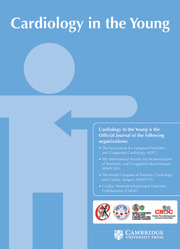No CrossRef data available.
Article contents
Comparison of morbidity and mortality outcomes of conventional and sutureless repair techniques in children with isolated total anomalous pulmonary venous drainage
Published online by Cambridge University Press: 03 February 2025
Abstract
The sutureless repair technique has been favoured due to its purported reduction in post-operative pulmonary venous obstruction rates. This study aims to compare the outcomes of conventional versus sutureless repair techniques in Total Anomalous Pulmonary Venous Drainage.
In this retrospective single-centre analysis (2012–2022), we evaluated children who underwent conventional or sutureless repair for isolated total anomalous pulmonary venous drainage, excluding complex cardiac anomalies and incomplete data. Patients were categorised into conventional (Group C, n = 58) and sutureless (Group S, n = 41) groups. Primary outcomes included mortality, morbidity, and post-operative complications. Statistical analysis included Mann–Whitney U, chi-square, and Fisher’s exact tests where appropriate.
Supracardiac type predominated in both groups (53.4% in Group C and 70.7% in Group S), with higher cardiac type frequency in Group C (24.1% versus 2.4%, p = 0.016). Early complications occurred in 58.5% versus 53.4% of cases in Groups S and C, respectively (p = 0.767). The mortality rate (17.2% versus 14.6%, p = 0.944) and post-operative pulmonary venous obstruction (21.2% versus 19.0%, p = 0.809) were higher in Group C, though not significantly. Mean cardiopulmonary bypass times were comparable between groups (105 versus 89 minutes, p = 0.424).
In this comprehensive analysis of paediatric Total Anomalous Pulmonary Venous Drainage repair, both conventional and sutureless techniques demonstrated comparable safety profiles and clinical outcomes. These findings suggest that surgical approach selection should be individualised based on patient characteristics and surgeon expertise. Further prospective studies with larger cohorts are needed to validate these observations.
Keywords
- Type
- Original Article
- Information
- Copyright
- © The Author(s), 2025. Published by Cambridge University Press



